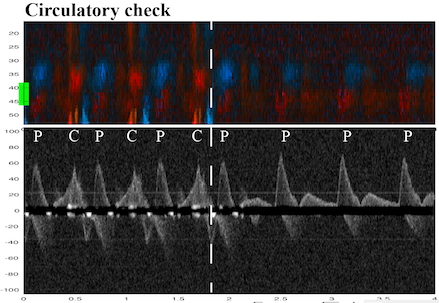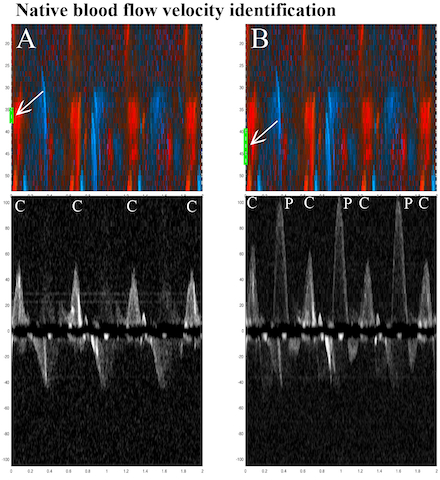Final ID: Sa202
Detection of Spontaneous Circulation During Chest Compressions with Hands-Free Carotid Doppler. An Animal Study.
Abstract Body: Background: During cardiopulmonary resuscitation (CPR), identifying the return of spontaneous circulation (ROSC) is challenging. Methods such as manual palpation, end-tidal carbon dioxide, and point-of-care ultrasound to detect ROSC are inaccurate, time-consuming, or intermittent. They may also require halting or prolonging no-compression time to identify signs of circulation. Maintaining a high compression fraction is associated with an increased likelihood of achieving ROSC.
Aim: This study aimed to investigate if using a novel continuous hands-free carotid Doppler system (RescueDoppler (RD)) could identify ROSC during chest compressions by distinguishing between spontaneous and chest compression-generated carotid blood flow velocity.
Methods: We used a porcine cardiac arrest model to investigate the RD. The RD probe was positioned and fixated over the carotid artery. An invasive blood pressure catheter was inserted in the contralateral carotid artery. An implantable cardioverter defibrillator (ICD) was utilized to induce sequences of ventricular fibrillation followed by defibrillation and chest compressions (cardiac arrest sequences). Compressions were administered manually at a rate of 100 or 50 compressions per minute or using a mechanical chest compression device (LUCAS). Doppler blood flow velocity curves were retrospectively analyzed for signs of ROSC by examining both spontaneous and/or compression-generated velocities (Fig. 1,2). We combined color M-mode and Doppler spectrum (Fig. 1) to differentiate between chest compression and spontaneous velocities.
Results: Data from eight animals (mean weight 30 kg) and 56 cardiac arrest sequences were included. In the analysis, chest compressions were identified as tissue movements through the whole spectrum of the color M-mode, in the spectral display (Fig. 1), or both. Spontaneous velocities were identified in a specific carotid depth of the color M-mode and between compression-generated peak velocities in the Doppler specter (Fig. 1). ROSC was confirmed by pausing chest compressions and evaluating ECG and invasive blood pressure. We identified spontaneous circulation during manual and mechanical chest compressions in 55 of 56 sequences.
Conclusions: In a porcine cardiac arrest model, with ROSC, we could differentiate between spontaneous circulation and chest compression-generated blood flow velocity of the carotid artery using RescueDoppler.
Aim: This study aimed to investigate if using a novel continuous hands-free carotid Doppler system (RescueDoppler (RD)) could identify ROSC during chest compressions by distinguishing between spontaneous and chest compression-generated carotid blood flow velocity.
Methods: We used a porcine cardiac arrest model to investigate the RD. The RD probe was positioned and fixated over the carotid artery. An invasive blood pressure catheter was inserted in the contralateral carotid artery. An implantable cardioverter defibrillator (ICD) was utilized to induce sequences of ventricular fibrillation followed by defibrillation and chest compressions (cardiac arrest sequences). Compressions were administered manually at a rate of 100 or 50 compressions per minute or using a mechanical chest compression device (LUCAS). Doppler blood flow velocity curves were retrospectively analyzed for signs of ROSC by examining both spontaneous and/or compression-generated velocities (Fig. 1,2). We combined color M-mode and Doppler spectrum (Fig. 1) to differentiate between chest compression and spontaneous velocities.
Results: Data from eight animals (mean weight 30 kg) and 56 cardiac arrest sequences were included. In the analysis, chest compressions were identified as tissue movements through the whole spectrum of the color M-mode, in the spectral display (Fig. 1), or both. Spontaneous velocities were identified in a specific carotid depth of the color M-mode and between compression-generated peak velocities in the Doppler specter (Fig. 1). ROSC was confirmed by pausing chest compressions and evaluating ECG and invasive blood pressure. We identified spontaneous circulation during manual and mechanical chest compressions in 55 of 56 sequences.
Conclusions: In a porcine cardiac arrest model, with ROSC, we could differentiate between spontaneous circulation and chest compression-generated blood flow velocity of the carotid artery using RescueDoppler.
More abstracts on this topic:
A Diagnostic Pitfall: Subclavian Stenosis Mimicking Severe Aortic Stenosis on Echocardiography"
Ezaldin Shady, Abdelsalam Mahmoud, Elsayed Omar, Lee Marciano
A pilot study of an intervention for self-management of blood pressure among refugees fleeing war and resettled in the United StatesBehnam Rawnaq, Godino Job, Celis Deisy, Anderson Cheryl, Al-rousan Tala


